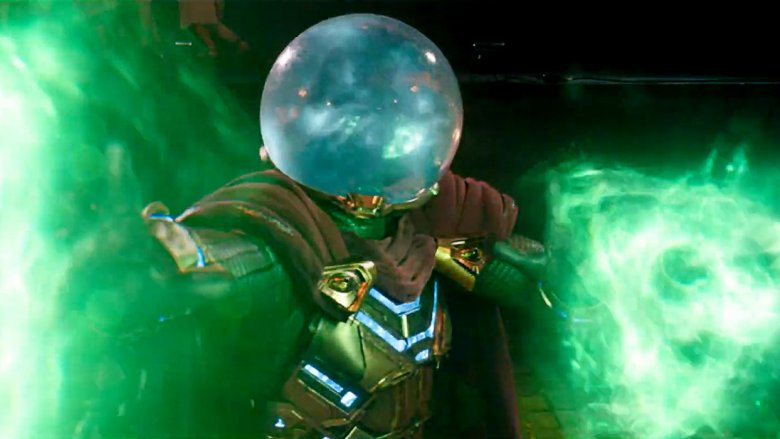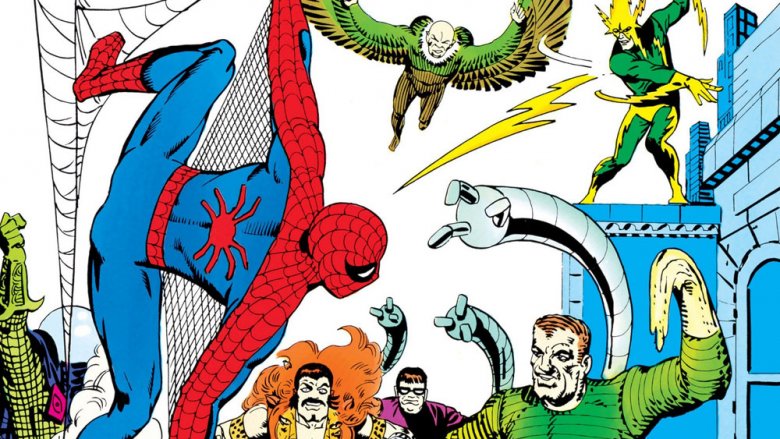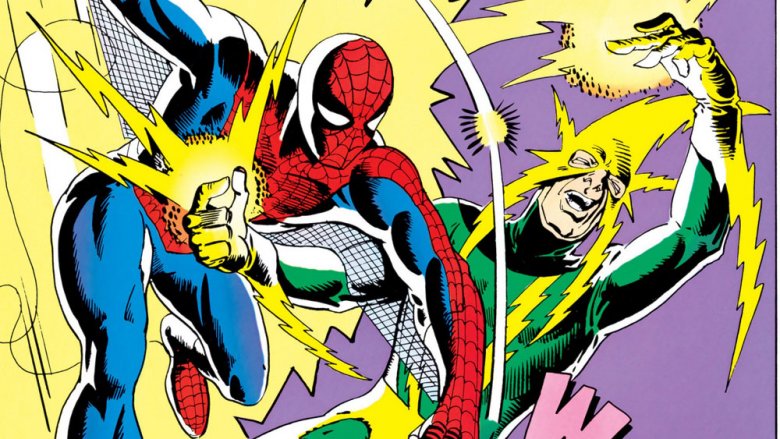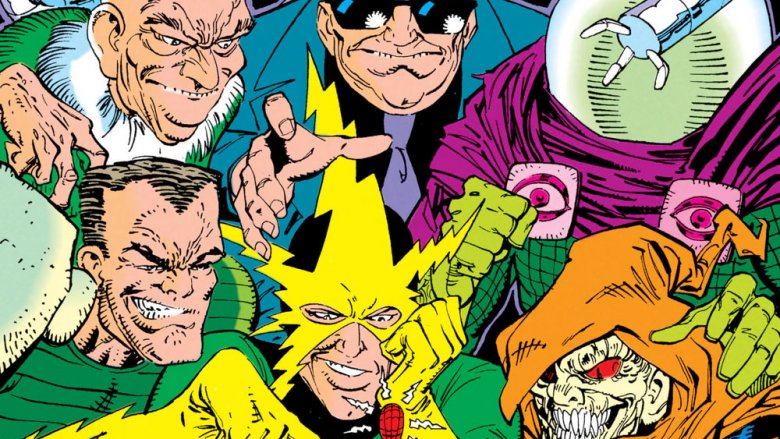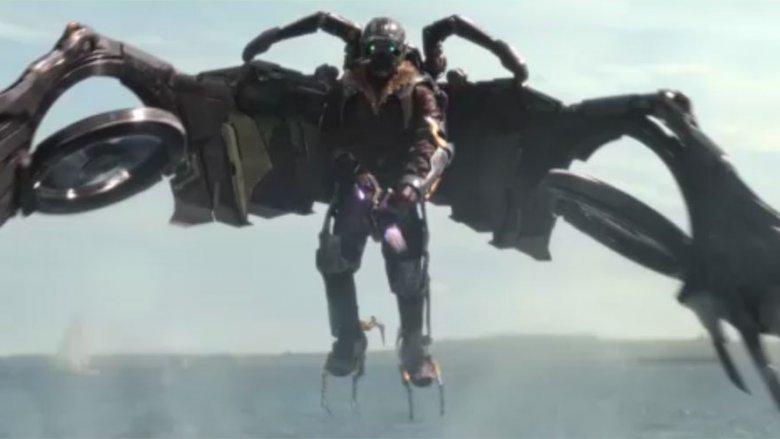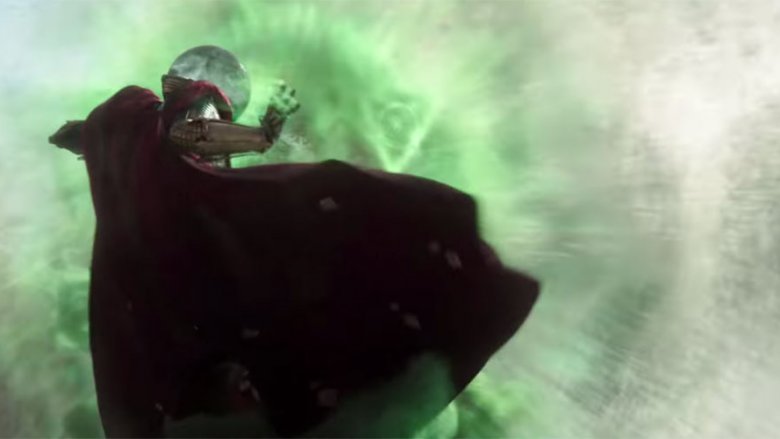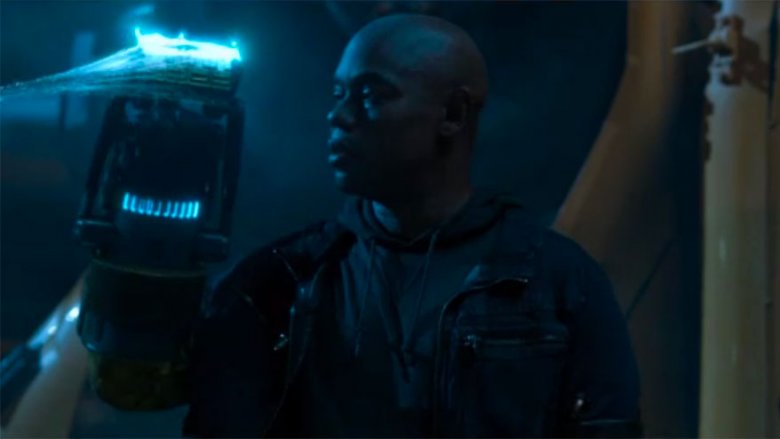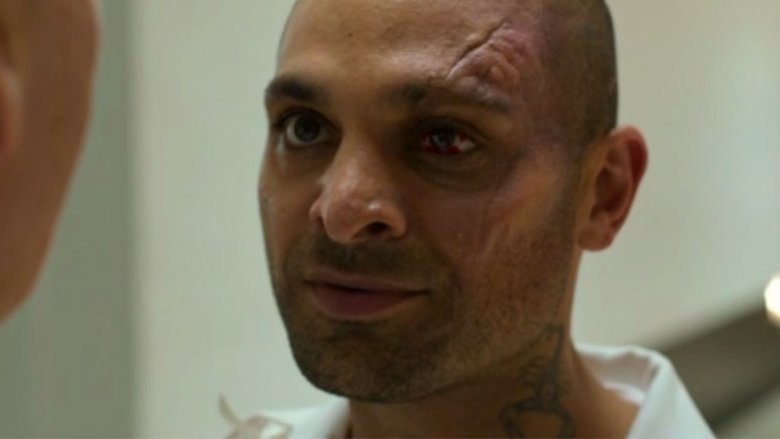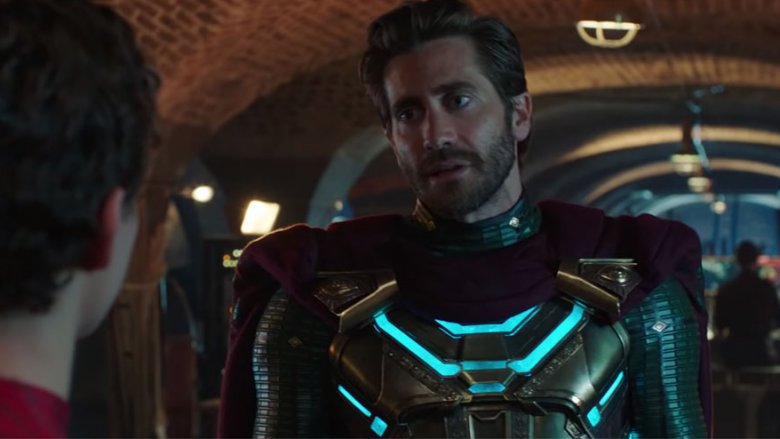How The Sinister Six Already Exist In The MCU
Spider-Man has always had some of the most compelling foes in comics. Who else could take a nearsighted, eight-limbed super-scientist or a captain of industry cosplaying as a D&D monster while throwing around exploding pumpkins and come away with some of the best superhero storylines of all time? It's one of the many reasons that he's such an easy character to bring to film, because his enemies are already in that sweet spot of being powerful enough to present a threat to a teenager who can bench press a car, while still having motivations, flaws, and gimmicks that are always fun to see in practice.
But while movies like Spider-Man 3 have flirted with the classic supervillain team-up, we've never really gotten a big-screen version of one of Spidey's most famous challenges: the Sinister Six. Now, however, it looks like that might be where the web-slinger's cinematic adventures are heading. It's not that they're going to introduce the Sinister Six in the MCU — it's that they might already exist, even if you've never noticed.
Who are the Sinister Six?
If you're not familiar with them, the Sinister Six have a history with Spidey that dates back all the way to 1964. While every issue advanced the superhero soap opera that was the Marvel Universe back then, the publishing schedule was punctuated by special oversized issues that, because they were meant to be a once-a-year spectacular, were called Annuals. Across the street at DC Comics, Annuals were pretty much just big reprints designed to get "classic" stories into the hands of readers who had missed them the first time around, often built around a theme. The Superman annuals, for instance, would showcase collections of stories that featured, say, Superman undergoing a strange transformation that turned him into an old man or a lion, something that happened pretty often back then. Also, they put out two Batman Annuals every year, because hey, why not?
At Marvel, things were done a little differently. While their Annuals did feature reprints of key stories, the lead story in every issue was not only all-new material, it was also something meant to be a pretty big deal. The Fantastic Four Annuals gave readers an origin for Doctor Doom, a war between Atlantis and the surface world, and the wedding of Reed Richards and Sue Storm, an oversized epic that guest-starred the entire Marvel Universe circa 1965, including Stan Lee and Jack Kirby themselves.
For the first Spider-Man Annual, the idea that Stan Lee and Steve Ditko came up with was one of the simplest ways to make a story feel important: if one supervillain could make a regular issue seem like a big deal, then why not throw in a few more? In fact, why not take virtually every Spider-Man villain who had been created over the past year and throw them all against Spidey in one massive all-out brawl?
The original Sinister Six lineup
When it hit the stands in Amazing Spider-Man #1, "The Sinister Six" clocked in at 41 pages, and contained some of Lee and Ditko's best work ever. The idea was simple: after escaping from prison, Doctor Octopus gathered five villains who wanted revenge on Spider-Man — Electro, the Vulture, Mysterio, the Sandman and Kraven the Hunter — and convinced them to set up a gantlet that would put Peter Parker through the wringer. After figuring out that Spider-Man had some kind of connection to them, Doc Ock kidnapped Betty Brant and Aunt May, leaving behind clues that would lead Spidey from one villain to the next. It was basically a scavenger hunt, but with a strong chance of being mauled by leopards.
Ditko punctuated each of the battles with a full-page splash of Spidey taking on the bad guys, which was something that wasn't actually seen that often back then. The editors of the '60s figured kids would feel ripped off if each page wasn't crammed full of story, but it's hard to imagine any fan looking at a massive shot of Spider-Man crashing through a wall to punch out Mysterio while threatening to "play a drum solo on that glass fishbowl" and think it was anything but awesome.
Needless to say, the story was a hit, and that original lineup — with Otto Octavius as the mastermind — would go down in Marvel history as one of the greatest villainous teams ever assembled.
The legacy of the Sinister Six
Surprisingly — or maybe not, since they hadn't actually managed to kill Spider-Man like they wanted to — the Sinister Six didn't make another appearance for a while. It wasn't until 1990 that we got the team's proper return in a story appropriately called "The Return of the Sinister Six." The only big difference was the addition of the Hobgoblin to the roster, replacing the temporarily deceased Kraven.
One of the key selling points was artist Erik Larsen re-creating the feel of Ditko's art with the same kind of full-page Spidey-versus-villain splashes. Unlike the original straightforward tale, however, the return was full-on bonkers. Not only did it see the death of Aunt May's elderly boyfriend Nathan, but it was built around Doc Ock manipulating the other villains into a world domination plot and then revealing that he was really doing was launching a satellite that would extort wealthy addicts by causing them to painfully convulse whenever they did cocaine. Fortunately, with the help of a face turn from the Sandman, Spider-Man was able to defeat Doc Ock and make the world safe for cocaine once again.
Despite that story's bizarre excesses, it cemented the Sinister Six as the Marvel Universe's premiere villain team, and paved the way for them to branch out in more ways than one. Not only did the team itself show up again — occasionally expanding to the Sinister Seven, the Sinister Twelve, and more — it also made them the go-to roster for media outside the comics. They've appeared as a team in multiple Spider-Man cartoons, as well as video games from the NES all the way to 2018's PS4 Spider-Man. They're even in Spider-Man: Turn Off the Dark, the broadway musical! With Carnage! The only place they haven't been yet is the movie theater... unless they've actually been there all along.
Sinister Six Cinema
If the Sinister Six do show up in the MCU, it's likely that it won't be the classic lineup that was introduced back in Amazing Spider-Man Annual #1, for one simple reason. With the exception of the Joker, who will not stop showing up even in films without Batman, movies tend to shy away from using the same villains that have been seen before with other versions of the character.
Before the MCU, half of the original roster had already shown up in Spider-Man movies. Doctor Octopus, played by Alfred Molina rocking the rarely seen "two trench coats at the same time" look, was in Spider-Man 2. The Sandman appeared alongside Venom and a dancing Peter Parker in Spider-Man 3. 2014's Amazing Spider-Man 2 brought in Jamie Foxx as Electro, and then used his head for the single weirdest DVD box set ever made.
As far as the other half of the classic lineup goes, the Vulture was the primary villain of Spider-Man: Homecoming, and Mysterio is set to step into the spotlight in Spider-Man: Far from Home. The only one who's missing entirely is Kraven the Hunter, but that's not a huge problem. There are, after all, more Spider-Man villains floating around the Marvel Cinematic Universe who could be used in his place — and there's even enough to make up for it if they don't want to use Doc Ock, Electro, and Sandman, either.
The superior (cinematic) foes of Spider-Man
In the span of a single film, Spider-Man managed to encounter more of his classic foes than Iron Man did in ten years. The obvious one, of course, was the Vulture, but he's just the tip of the villainous iceberg. On the off chance that you missed it, take a closer look at Adrian Toomes and the cabal of high-tech arms dealers that used to be his construction crew, and you'll see both the Shocker and the Tinkerer — who debuted alongside the Vulture back in Amazing Spider-Man #2. As for the customers buying those high-tech weapons, there's an appearance by the Prowler and the Scorpion, who, thanks to Into the Spider-Verse, wound up being two unlikely picks for Spider-Foes who would both make it into two different movie universes in the span of 18 months.
That's five major Spider-Man villains — well,four major villains and the Tinkerer, really — and they're just the ones we know for sure. Peter has a science teacher named "Ms. Warren" in that movie who might very well turn out to be the MCU's version of the Jackal, who in the comics is Peter's old science teacher, Miles Warren. Of course, that's just if, for some reason, they want to do a movie about Spider-Clones in spite of everyone who was reading Spider-Man comics in the '90s begging them not to. And hey, if you really want to get technical about it, they even have two different Venoms in that movie, too!
That leads us to Far from Home. We already know that Mysterio is going to be the star of the show in some form, although whether or not he's an actual "villain" (he is) remains to be seen. He's probably not the only bad guy who's going to show up, though. As many Spider-Fans have theorized since that first trailer hit — and as the movie's tie-in Lego sets seem to confirm — that big water creature, if it's not an illusion, might just be Morris Bench, better known as Hydro-Man. There's also a brief glimpse of a very sandy man and some kind of molten man (another one who shows up in Lego form) in there, too. Even if they do turn out to be Mysterio's trickery, that's a whole lot of villains for one spidery teen, no matter how radioactive his blood might be.
Assembling a rogues' gallery
Generally speaking, superhero movies have a villain problem. Not only do the villains tend to fall into the same role as far as being direct counterpoints to the heroes — Iron Monger, Justin Hammer, Yellowjacket, Kaecilius, the Abomination, and so on are functionally just palette-swapped versions of the good guys — but they also have an unfortunate tendency to die after a single film. Even when the villains are interesting and compelling in their own right, like Erik Killmonger in Black Panther, they usually only last for a single film before they're killed off. Or they used to be, until Homecoming.
Admittedly, there were MCU villains who stuck around before that, including Helmut Zemo in Captain America: Civil War and Baron Mordo in Doctor Strange. Thanos also appeared in a handful of movies, although he managed to die twice in the last one, which kind of makes up for it. Think about other major Marvel villains, though. The Red Skull, who's been Captain America's arch-nemesis for 70 years in the comics, was blasted off into a wormhole at the end of The First Avenger and got a new job as the galaxy's spookiest tour guide on Vormir. Ultron, whose entire deal is that he comes back deadlier every time he's defeated, was thoroughly obliterated at the end of the film that bears his name. Ego the Living Planet was blown up after fighting a giant holographic Pac-Man. These are powerhouse villains in the comics who just cease to exist in the films.
And that makes sense, too. As much as the MCU films form an ongoing universe, they're not made for the perpetual publication schedule that comics have, so there's no real reason to keep the bad guys around if you think you can tell a more compelling story by killing them. Once again, Killmonger is the prime example of a villain whose death is meant to mean something larger than just the end of the film. The thing is, when that's the default setting that every movie goes with, it stands out when the villains don't die. Loki, for instance, has turned into a snake and stabbed his way into the hearts of moviegoers across the world precisely because he just keeps surviving to get another one over on Thor. It becomes a universe where characters only stick around if, like Loki, there are plans for them in the future.
The Sinister Six: Hiding in plain sight
Homecoming, though, feels very different from the other movies. It makes a point of keeping its villain around, partly because the movie is structured as a point-by-point rejection of the formula laid out by Iron Man back in 2008, and partly because rescuing the guy who told you about an hour ago that he was going to kill everyone you loved because it's the Right Thing To Do says a lot about who Peter Parker is and why he does what he does.
That leads to the epilogue in prison, where the Vulture encounters Mac "The Scorpion and Also Technically Venom" Gargan. On the surface, it feels like another subversion of what we expect from the superhero movie formula: when he's given the chance to assemble a team of villains and get revenge and reveal Peter's secret identity, Toomes doesn't take it. Whether it's because he's not the bad guy he pretends to be when he threatens Peter in the car — which seems unlikely because he buries him under a few tons of warehouse cement immediately after — or because he realizes he owes Spider-Man his life, he gives up on the opportunity.
The scene shows us something else, though. The fact that Gargan is still around and trying to make connections with other people who want revenge against Spider-Man shows that the groundwork is already there for exactly the kind of story we saw way back in Amazing Spider-Man Annual #1. If nothing else, Spider-Man is the first hero in the entirety of the Marvel Cinematic Universe to have six enemies who are both mad at him and still alive.
The Cinematic Sinister Six
All of this is, of course, pure speculation, but it's pretty easy to look at a movie where the bad guys are kept around and — given that the MCU has just shown us how much it can build on its own continuity — assume that this is all building to something big.
It's also pretty easy to imagine how it could go down. In the absence of a master planner like Doc Ock, Mysterio seems like a good candidate to get everyone together — assuming, of course, that he is in fact a villain and not a heroic multiversal champion like he claims. Hydro-Man fits pretty easily into the same role as the Sandman, without the baggage of being in one of the worst-received Spider-Man movies, and the same goes for the Shocker replacing Electro. As much as fans would love to see his crop-top lion vest and leopard print capri pants, Kraven could be easily substituted with a revenge-seeking Lizard. If the Vulture's out, the Jackal could conceivably fill the role of the older science weirdo. Throw in the Tinkerer as the wild card-slash-tech guy, and that's a pretty solid Sinister Six. And again: those are just the characters we know about. With as many as they introduced in Homecoming, would it really surprise anyone if Far from Home tossed in Tombstone and Stegron the Dinosaur Man for good measure?
From a storytelling standpoint, building to the Sinister Six might not even be necessary. As much as we love to imagine Spider-Man as the everyman hero who balances his superheroic life with his everyday problems, that requires a Spider-Man who's always struggling against the odds. Meanwhile, the cinematic Peter Parker has crammed a whole lot of living into a very short time. In the three years since he was introduced, the MCU's Spider-Man has gone toe-to-toe with Captain America, rocketed off to outer space, fought Thanos on the other side of the universe, spent five years as a pile of dust before being resurrected from the dead, and fought Thanos again on Earth alongside dozens of other superheroes, including at least two literal gods. It's kind of hard to go back to just fighting the Rhino after that.
The Rhino and five of his very angry buddies, on the other hand, sounds about right.
